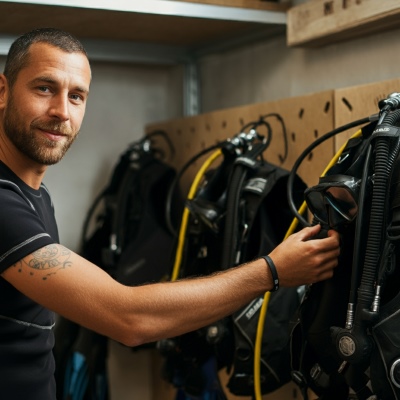
Picture this: It's a beautiful Saturday morning, and you're ready to hit the water for a dive. You excitedly head to your gear storage area, only to be greeted by a chaotic jumble of wetsuits, BCDs, and tangled hoses. Where's your mask? Did your fins sprout legs and run away? And is that a mysterious fungus growing on your regulator?
Okay, maybe it's not that dramatic, but we've all been there. Improper gear storage can lead to frustrating searches, damaged equipment, and even missed dive opportunities. At Dive Right In Scuba, we believe that organized gear is happy gear. And happy gear makes for happy divers!
So let's dive in (pun absolutely intended) and explore some savvy storage solutions to help you keep your scuba equipment in tip-top shape and ready for adventure at a moment's notice.
Location, Location, Location: Finding the Ideal Storage Spot for Your Dive Gear
Before we delve into the nitty-gritty of storage solutions, let's talk about where you should actually keep your beloved scuba gear.
- Climate Control: First and foremost, your gear needs a comfortable home, just like you do! Ideally, you want a cool, dry, and well-ventilated area to prevent mold, mildew, and corrosion. Think of it as a vacation home for your gear - no humid basements or scorching attics allowed!
- Space Considerations: We get it; not everyone has a dedicated dive room. But don't worry, even a small space can be optimized for gear storage. Think creatively! Utilize under-bed storage containers, vertical wall space in your garage, or even a designated corner in your closet.
- Accessibility: The last thing you want is to be rummaging through boxes and bags every time you want to go diving. Keep your gear easily accessible, so you can grab and go at a moment's notice.
Storage Solutions: From Hangers to High-Tech Containers
Now that you've found the perfect spot, let's talk about how to organize your gear like a pro.
- Wetsuits and Drysuits: These neoprene wonders need to be hung up to dry and stored properly to maintain their shape and prevent creases. Invest in sturdy hangers designed for wetsuits and drysuits, and avoid folding or crumpling them for long periods.
- BCDs: These buoyancy wizards deserve a little TLC too. Partially inflate your BCD and hang it upside down to prevent water from pooling in the bladder. Store it in a cool, dry place, away from direct sunlight and heat.
- Regulators: Your regulator is your underwater lifeline, so treat it with care! Rinse it thoroughly with fresh water after each dive and store it in a cool, dry place with the first stage upright. This prevents any residual water from entering the delicate internal mechanisms.
- Masks, Fins, and Snorkels: Keep these smaller items organized and protected in mesh bags or dedicated containers. This will prevent scratches and damage, and make it easy to grab what you need without digging through a pile of gear.
- Smaller Accessories: Dive computers, compasses, and other small but essential items can easily get lost or damaged. Consider using dry boxes, gear bags with compartments, or even a simple tackle box to keep them organized and safe.
- The Slatwall Solution: If you're serious about gear organization, consider installing a slatwall system in your garage or dive room. This versatile system can be customized with hooks, hangers, and baskets to create a personalized gear storage wall that's both functional and aesthetically pleasing.
Maintenance and Care: Keep Your Gear in Tip-Top Shape
Proper maintenance is key to extending the life of your gear and ensuring its optimal performance. Follow these tips to keep your equipment in prime condition:
- Post-Dive Rinse: After every dive, rinse your gear thoroughly with fresh water to remove salt, sand, and other corrosive elements. This simple step can prevent damage and prolong the life of your gear.
- Thorough Drying: Make sure your gear is completely dry before storing it. Hang wetsuits and BCDs, and use a towel to dry masks, fins, and snorkels.
- Lubrication: Apply a thin coat of silicone grease to O-rings, zippers, and other moving parts to prevent them from sticking, corroding, or leaking.
- Regular Inspections: Inspect your gear regularly for signs of wear and tear, such as frayed straps, cracked hoses, or loose buckles. Address any issues promptly to prevent them from escalating into bigger problems.
Travel Tips: Pack Your Gear Like a Pro
Heading out on a dive trip? Make sure your gear arrives safe and sound with these packing tips:
- Gear Bags and Luggage: Invest in a sturdy and well-organized gear bag to protect your equipment during travel. Consider a hard case for delicate items like cameras and regulators.
- Packing Strategies: Pack your gear efficiently, using towels or bubble wrap to cushion delicate items and prevent them from shifting during transit.
- Carry-On vs. Checked Baggage: Weigh the pros and cons of each option. Carry-on allows you to keep your gear close, but checked baggage might be more convenient for larger items.
Gear Up and Dive In: Keep Your Equipment in Top Shape
Your scuba gear is your trusty companion in your underwater adventures. Show it some love with regular maintenance, and it'll reward you with years of reliable performance. Remember, a little TLC goes a long way!
And if you ever need a helping hand, the experts at Dive Right In Scuba are here to help with all your gear maintenance and repair needs.
